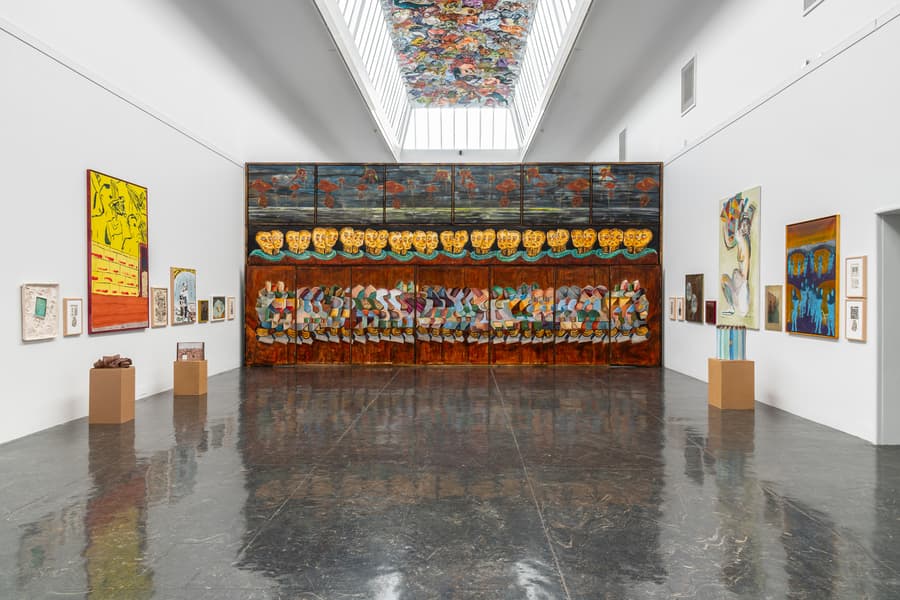Lage Lindell
Catalog text
Lage Lindell born in 1920 in Stockholm, active there as a painter for almost 40 years, has executed monumental paintings in the Court of Appeal Sundsvall, Västerås City Hall, Solna City Hall, Umeå University.
The style. . .
— perhaps the result of a consideration: what means are best suited to express what is to be expressed? In the force field that arises from such a thought, a kind of hierarchy is immediately established, because the means available must of course be more or less expedient. And when an artist has finally found the most expedient means, then he has also found his style — as when Monet arrived at the patches of free paint and thus became an Impressionist. But originally the word sti/ just meant writing pen, stylus. You got the style you got through the stylus you happened to get.
Of course, Lage Lindell — especially in the past — has considered which means were most expedient for him; yet — nowadays his style is hardly more than the pen, which after forty years of drawing has become one with his hand. In his case the word sti/ has regained its original meaning. — He also says that he now writes his pictures.
He fills a surface — from left to right — and tries to make the shapes hang together as rhythmically as the letters in a scribbled letter. Although the letters in a letter and the shapes in a picture are still two different things, they convey different things. A line in an image is a contour: it suggests a thickening on one side and a thinning on the other. The line of a letter does not. — The drawn line highlights volumes from the paper, a paper that immaterializes, thins — and deepens — into space around the volumes that are highlighted. — Lage Lindell's style: the hand-pen stroke which with utmost clarity and power releases volume and space from the paper.
The difference is simple: if the rest of us were to draw a circle freehand, it would look like a ring, a zero, while Lage Lindell's circle would immediately feel like a sphere, a volume — and immediately give an idea of how much that sphere weighed , whether it was hard or soft, whether it fell or lifted, whether it was distant or near . . . That's his style. It is in his hand — or in his pen.
And it is only to a small extent the result of considerations; most of it comes from sensitivity and work — from sensitivity trained through work. Through mastery, the stories become possible: the circle is a head — a child can do that! — but through the volume the circle evokes, the head becomes heavy or light, tormented or laughing. And then the paint does the rest. (The color clarifies the spatiality, the volumes: if a blue shape has yellow shapes on both sides-
as they die, the yellow shapes tend to coalesce into a single yellow shape behind the blue. To take just one example — the variations are countless.)
This is what Lage Lindell said:
— I am theatrical. I can't do anything about nature on a normal day, but when it thunders, or when the sun goes down, when it's dramatic. , .
It is the same with the figures he 'writes'. They are dramatic—violent often, pathetic, moving and swift, fleeing like Rodin's, subject to sudden foreshortening like the figures in Baroque plafonds. They are called forth one by one, written from left to right like the words in a story, the meaning of a figure becomes clear only through a following figure, whose gesture becomes a reply to the previous one —
etc. It is not new that the bodies are anatomically incomplete — only Lage Lindell's shorthand style is new. Rilke once wrote of Rodin:
The sculptures without arms convey the whole: nothing important is missing. You are faced with something completely when you see them. The feeling of something incomplete does not arise through the way something looks, but through pedantic notions of how something should look. (— — —) Through the education Rodin has given himself, he knows that a body consists of ideal scenes from life, from a life that can be great and outstanding in every detail, and therefore he has also succeeded in giving the whole independence to each part . Lage Lindell has done the same. A detail foot e.g. — feels like a whole figure, because the movement of the foot is so precisely represented that the rest of the figure becomes clear, albeit implied. The whole — the scene from life — is still played out.
It is a flow, an uninterrupted story, where the burden of the volumes is carried forward by the style. And as Buffon wrote in one place in his Histoire naturel/e: »Style is man himself.»
Ulf Linde


